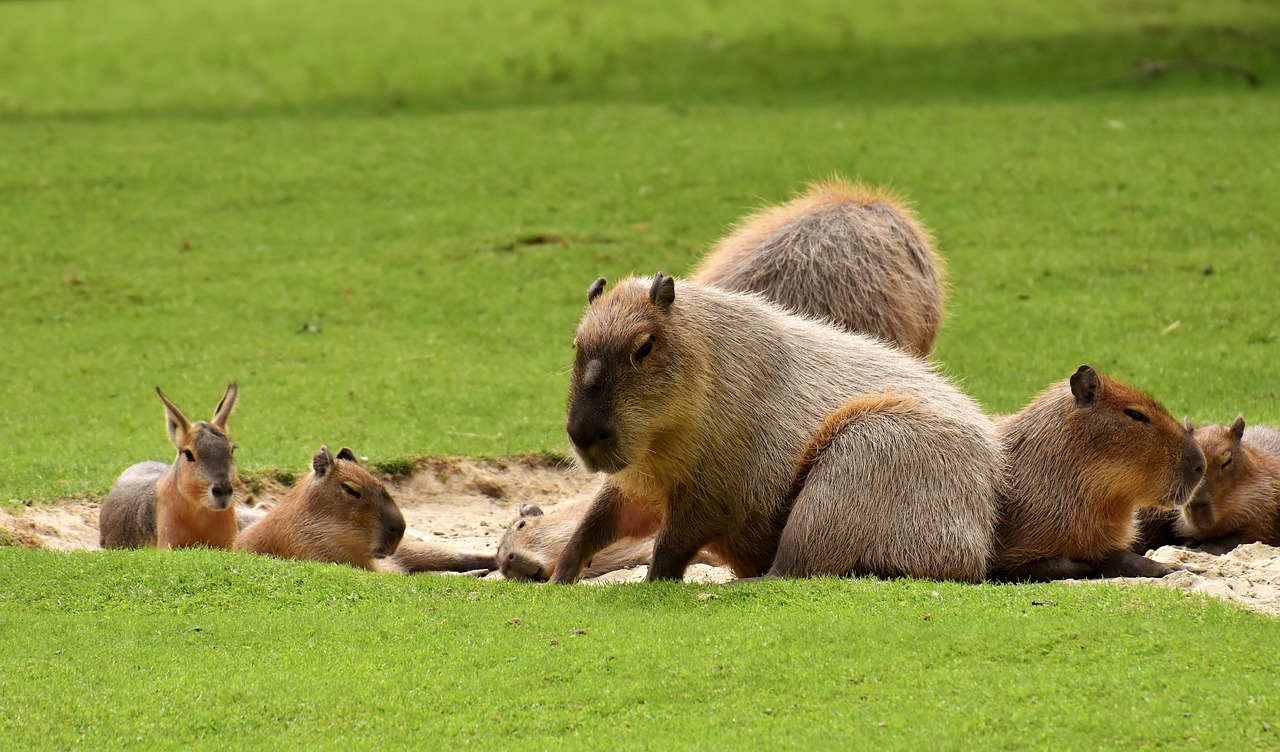In the heart of South America, amidst lush wetlands and sprawling grasslands, reigns a charismatic giant – the capybara (Hydrochoerus hydrochaeris). This gentle, semi-aquatic rodent holds the crown as the world’s largest, captivating heart with its chill demeanor and charmingly oversized features. But beneath the surface of cuddliness lies a fascinating story of evolution, resilience, and an intricate life cycle adapted to its unique tropical haven.
Table of Contents
Scientific Name
The capybara, known scientifically as Hydrochoerus hydrochaeris, is a member of the Hydrochoeridae family. Its scientific name reflects its semi-aquatic nature, emphasizing its affinity for water.
Types of capybara
While the capybara is a single species, there are variations in size and features among populations. Geographical differences contribute to these variations, leading to regional distinctions that enthusiasts often observe. However, they all fall under the same scientific classification.
Evolutionary Insights
The evolutionary journey of the capybara is a testament to adaptation and survival. Belonging to the order Rodentia, they have evolved over millions of years to become the remarkable semi-aquatic herbivores we know today. Their large size and distinct features have helped them thrive in diverse environments.
Behavior
Capybaras are renowned for their social nature, forming tight-knit groups that provide numerous benefits. They engage in communal grooming, and vocalizations, and share responsibilities in protecting the group from potential threats. This social structure is a crucial aspect of their behavior, contributing to their survival and well-being.
Habitat Preferences
They are highly adaptable and found in a variety of habitats across South America. From lush rainforests to open grasslands and riverbanks, they navigate diverse environments with ease. Their semi-aquatic lifestyle is facilitated by their ability to swim proficiently, making water sources a vital component of their habitats.
Diet
Capybaras are herbivores with a diet primarily consisting of grasses and aquatic plants. Their digestive systems are adapted to extract nutrients from fibrous vegetation, showcasing their role as essential grazers in their ecosystems. They play a crucial part in maintaining ecological balance by controlling vegetation growth through their feeding habits.
Predators and Threats
While capybaras are formidable in their groups, they face threats from natural predators such as jaguars, anacondas, and caimans. Additionally, human activities, including habitat destruction, poaching, and road accidents, pose significant challenges to capybara populations.
Reproduction, Babies, and Lifespan
Capybaras reproduce through sexual reproduction, with females giving birth to litters ranging from two to eight pups. Their communal nature extends to their approach to raising offspring, as multiple females within the group may contribute to caring for the young. Their lifespan varies, with individuals living up to 8-10 years in the wild.
Population Status
While capybaras are not currently classified as endangered, localized threats to specific populations exist. Conservation efforts are crucial to ensure the sustained well-being of capybara populations, especially in regions facing habitat degradation and human-induced pressures.
Conclusion
In conclusion, the capybara, with its scientific wonders, diverse types, and vital ecological role, stands as a fascinating testament to the intricate balance of nature. By understanding their behavior, habitats, and the challenges they face, we pave the way for active conservation and appreciation of these extraordinary rodents.
Frequently Asked Questions (FAQs)
- Are capybaras good swimmers?
- Yes, they are excellent swimmers. They use their partially webbed feet to navigate water bodies with ease.
- Can they be kept as pets?
- While some countries allow capybaras as pets, they have specific care requirements and may not be suitable for domestic settings.
- Do capybaras form bonds with other animals?
- They are known to form bonds with other animals, including birds and other rodents. Their gentle nature contributes to their ability to coexist with various species.
- How do they communicate?
- They communicate through vocalizations, including barks, purrs, and whistles. They also use body language to convey messages within their groups.
- Why are they considered keystone species?
- They are considered keystone species because of their significant impact on their ecosystems. As herbivores, they influence vegetation growth, contribute to nutrient cycling, and provide a food source for predators.
